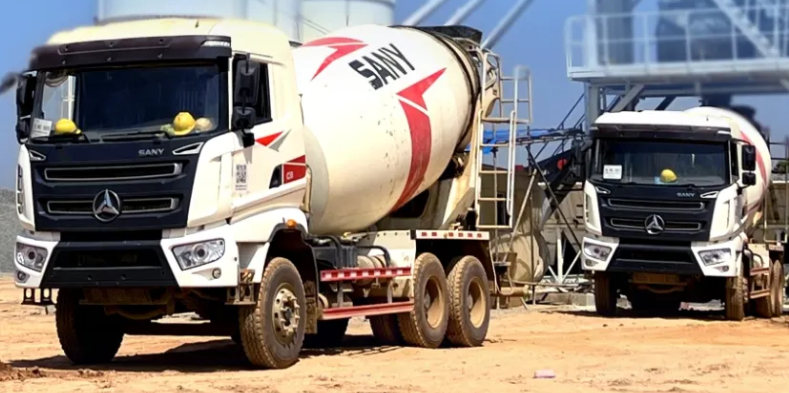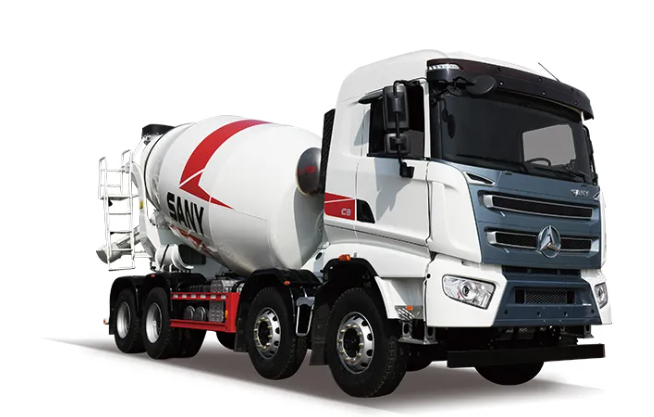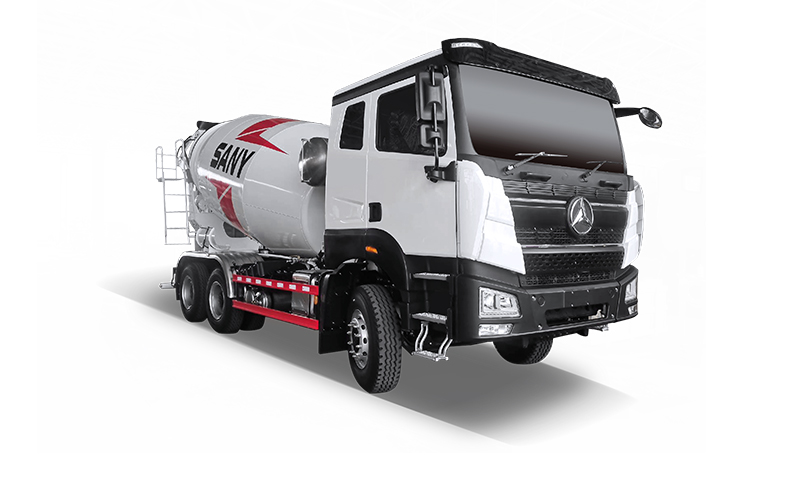How Does Concrete Mixer Truck Work? Essential Insights for Construction Workers
This guide explains how does concrete mixer truck work, offering solutions for equipment selection, usage, and maintenance based on your construction needs.
Concrete is a composite material made by mixing cement, aggregates, water, and additives in specific proportions to form a solid mass. It is widely used in civil engineering projects such as buildings, bridges, roads, and tunnels. The uniformity, slump, and other key quality indicators of concrete are closely related to the selection and use of concrete mixer trucks. So, what exactly is a concrete mixer truck? How does a concrete mixer truck work? What types of this construction equipment are available? If you're interested in these questions, read on to find out more in this guide.

What Is a Concrete Mixer Truck?
A concrete mixer truck, also known as a cement mixer truck, is a specialized vehicle used for transporting and mixing concrete. It consists of several components, including the vehicle chassis, mixing drum, transmission system, water supply system, and loading/unloading devices.
Core Functions of the Equipment
- Transporting Concrete: The truck efficiently and safely delivers ready-mixed concrete from the batching plant to the construction site, meeting on-site requirements.
- Preventing Segregation and Setting: During transportation, the mixing drum keeps rotating to ensure the uniform mixing of the concrete, preventing separation, settling, or premature setting, thus ensuring good workability.
- Assisting in Mixing and Adjusting Slump: Upon reaching the construction site, the concrete can be further mixed as needed to meet the construction requirements, ensuring proper pouring quality.
Functions of Various Components
- Vehicle Chassis: Typically built on a multi-axle heavy-duty truck chassis, it includes the chassis frame, engine, and drive system, providing power and a foundation for movement.
- Mixing Mechanism: The mixing drum is often shaped like a double cone or pear, welded with spiral blades inside. A hydraulic system keeps the drum rotating and pushes the concrete via the blades.
- Hydraulic System: This includes a hydraulic pump, motor, and gearbox, which convert engine power into rotational power for the mixing drum.
- Water Supply System: Comprising a water tank, pump, and piping, this system is used for adding water during mixing and cleaning the drum after use.
- Loading/Unloading System: Includes the loading and unloading hoppers, chutes, and discharge openings, enabling the loading and unloading of concrete.
Additionally, concrete mixer trucks often feature a control system for the mixing drum and hydraulic systems to ensure operational efficiency and convenience for the operator.
How Does a Cement Mixer Truck Work?
The typical operation process of a concrete mixer truck involves three main stages: loading, mixing and transportation, and unloading.
1.Loading Stage
At the concrete batching plant, the truck receives dry mixed ingredients such as cement, sand, and aggregates, along with water for subsequent mixing. During this phase, the mixing drum rotates at a low speed, lifting and initially mixing the materials.
2.Mixing and Transporting Stage
Once loaded, the truck transports the concrete to the construction site. During transportation, the mixing drum continuously rotates in a clockwise direction at a set speed, mixing the concrete using internal blades to prevent segregation and moisture separation.
If the concrete becomes too stiff or dry during transit, additional water can be added via the water supply system to adjust the mix and consistency.
3.Unloading Stage
Upon arrival at the construction site, the concrete is unloaded. If the concrete meets the required specifications, the unloading chute is aligned with equipment like concrete pumps or hoppers. The mixing drum rotates counterclockwise at an appropriate speed to push the concrete along the blades towards the discharge opening, completing the unloading process.
After unloading, remember to clean the mixing drum. Water can be added, and the drum rotated to prevent any leftover concrete from hardening inside the drum, ensuring its continued efficiency for future use.
What Types of Mixer Trucks Are There?
Concrete mixer trucks, often referred to as "mobile factories" for transporting concrete, come in various types. Whether it’s the chassis type that carries the key components, the unloading method that impacts efficiency, or the tank capacity suited to different construction needs, each classification corresponds to specific operational advantages and requirements. Operators should choose the appropriate model based on their project needs.
By Operational Mode
This is a common classification, directly impacting the mixing timing and operational efficiency, with two main types:
- Batch Mixer Trucks: These trucks mix a fixed amount of concrete per batch. After unloading, a new batch is mixed. The advantage is better control over material proportions and mixing precision, but it is less efficient and better suited for small to medium-sized projects or projects requiring frequent adjustments in concrete mix.
- Continuous Mixer Trucks: These trucks can continuously load, mix, and unload concrete without interruption. Although less flexible than batch mixers, they significantly enhance efficiency, especially in large projects where continuous concrete supply is needed.
By Unloading Direction
The location of the unloading outlet can affect the convenience of parking on-site and the unloading coverage. Based on this, there are several types:
- Rear Discharge Mixer Trucks: The discharge outlet is located at the rear of the vehicle, with a foldable chute to direct concrete to the construction site. This simple structure is cost-effective and requires minimal maintenance, but the coverage range is limited, and manual assistance might be needed in some situations.
- Side Discharge Mixer Trucks: The discharge outlet is positioned on the side of the truck, allowing it to unload without the need to reverse the vehicle. This type offers high flexibility, making it ideal for complex sites, such as narrow construction areas.
- Front Discharge Mixer Trucks: Less common, these trucks have the discharge outlet located at the front of the truck, just behind the driver’s cab. The chute extends forward, allowing the truck to face the construction site directly. This is ideal for high-rise concrete pouring, such as roof casting in low-rise buildings.
Besides these two main classification methods, concrete mixer trucks can also be further categorized based on chassis structure, concrete water content, equipment capacity, and other factors. However, these details are beyond the scope of this guide.
How Long Can You Keep Cement in a Cement Truck?
Due to the irreversible chemical reaction between cement and water, the quality of concrete (including its strength and workability) rapidly deteriorates after this process. The duration that cement can be kept in a cement truck depends on several factors, including environmental temperature, the concrete mix design, and the use of retarders. The storage time for cement in a cement mixer truck primarily depends on the material’s state (dry or wet) and the type of truck used. Here’s how they differ:
Dry Mix Cement (Bulk, Unhydrated Cement, Transported in Dry Mix Mortar Trucks)
Dry mix cement is an unhydrated bulk powder transported in sealed, moisture-proof trucks. It has a relatively longer storage time, but it must meet "sealed and dry" conditions.
- Typical Storage Duration: When the truck is properly sealed and stored in a dry environment (no rain or moisture infiltration), it can be stored for 3–7 days.
- Key Influencing Factors: If the seal fails (e.g., leaks at the truck opening, aging seals) or the humidity is high (e.g., rainy or humid regions), the cement may absorb moisture and clump, leading to a decline in quality within 3 days. (Clumps need to be broken and sieved, or else they will affect strength.)
- Notes: For long-term storage (over 7 days), even if sealed, moisture left inside the truck may gradually react, reducing cement activity. It is recommended to use dry material stored for a shorter period.
Wet Mix Concrete (Mixed with Water, Transported in Concrete Mixer Trucks)
Wet mix concrete is a "semi-finished product" already mixed with water. The truck must continuously rotate at a slow speed to prevent setting, and the storage time is very short, limited by the initial setting time of the concrete.
- Typical Storage Duration: Wet mix concrete must be used before the initial setting begins, typically within 2–4 hours at room temperature (20–25°C).
- Temperature Influence: The higher the temperature, the faster the initial setting — in summer (above 30°C), it may shorten to 1.5–2.5 hours, while in winter (below 5°C), it may extend to 4–6 hours (but freezing must be prevented).
- Absolute Prohibition: Once the concrete starts to set (indicated by a loss of workability and surface hardening), it cannot be used. Forced mixing can destroy its internal structure, significantly weakening its strength and failing to meet project requirements.
In conclusion, dry mix cement (in sealed trucks) can last 3–7 days (must be kept dry and sealed), while wet mix concrete (in mixer trucks) lasts 2–6 hours (must be temperature-controlled and continuously rotated, based on initial setting time). For both types, it's always best to "use immediately" to avoid compromising the final performance of the cement or concrete.
How Much Concrete Does a Mixer Truck Hold?
This usually depends on the concrete mixer truck’s loading capacity. You can classify the truck based on the mixing drum’s volume, as follows:
- Small Concrete Mixer Trucks: Typically, these trucks have a mixing drum capacity of ≤ 6m³. They are limited in capacity but highly flexible, making them suitable for small-scale construction projects such as indoor renovations or rural self-built homes.
- Medium-Sized Concrete Mixer Trucks: These trucks have a mixing drum capacity typically ranging from 7–11m³. They offer moderate capacity and are suitable for medium-sized construction projects such as residential buildings or small commercial buildings.
- Large Concrete Mixer Trucks: These trucks have a mixing drum capacity of ≥ 12m³, and some extra-large trucks can reach up to 20m³. They are used for large-scale, high-intensity construction projects such as bridges, tunnels, and large commercial complexes.
For example, the SANY Over 10m³ Truck Mixer — SY412C-6W has a 12m³ mixing capacity. It also comes with an 800L water tank and a powerful engine, easily handling large volumes of concrete transport and mixing tasks.

If you need concrete Truck Mixer with other capacities, SANY offers a wide range of professional choices, accurately matching different construction site requirements.
Maintenance Tips for Concrete Mixer Trucks
Developing good maintenance habits and establishing a scientific and comprehensive maintenance plan can effectively ensure the operation of the mixing drum, transmission system, hydraulic devices, and other core components. This will extend the service life of the equipment, safeguard construction safety, and maintain concrete quality.
Basic Pre- and Post-Operation Checks
Before each trip, check the power and transmission systems of the concrete mixer truck. Ensure that the mixing drum rotates smoothly and check the discharge chute and water tank levels. After returning, thoroughly rinse the inside of the mixing drum to remove any remaining concrete, and clean the chute, feed hopper, etc.
Periodic Maintenance of Core Components
Key components such as mixing drum blades, seals, hydraulic systems, and transmission systems may develop minor faults during use. You need to conduct in-depth inspections and maintenance on a regular basis to prevent small issues from worsening. For instance, check the blade wear every week and perform regular maintenance on the hydraulic system monthly.
Comprehensive Vehicle Maintenance
It is recommended to conduct a full inspection of the concrete mixer truck every quarter and a deep check of core components every six months. If any issues are found, address the faults and replace worn-out parts promptly. Also, make sure to keep maintenance records to facilitate future troubleshooting and fault analysis.
Conclusion
How does a concrete mixer truck work? To leverage the full potential and advantages of this specialized construction equipment, effectively improving work efficiency and safety, you need to select the appropriate type and capacity of concrete mixer truck based on your construction needs. In addition, a comprehensive maintenance system comprising “daily checks, specialized maintenance, and regular servicing” is essential to ensure the equipment is used safely and efficiently.
FAQs
How does a concrete mixer truck work?
As a specialized vehicle designed for transporting and mixing concrete, the work process of a concrete mixer truck primarily consists of three steps:
- Loading, Transporting, and Discharging: During loading, construction workers load cement, sand, gravel, water, and additives into the mixing drum through the intake port.
- After loading, the mixing drum continues to rotate clockwise at a set speed, ensuring that the various components of the concrete remain evenly mixed throughout transportation.
- Upon arrival at the construction site, the mixed concrete can be discharged from the unloading port into equipment such as concrete pumps or hoppers for further use.
What are common problems with mixer trucks?
Due to the high-intensity operations of mixer trucks or improper maintenance, various faults may occur, affecting both concrete quality and construction safety. Common issues include slow rotation of the mixing drum, slow discharge or incomplete discharge, and issues with the water supply system (either no water or insufficient water). To address these problems, it's important to promptly identify the cause of the fault and carry out targeted repairs. Additionally, regular preventive maintenance is essential to reduce the likelihood of future failures.
How does concrete not harden in a truck?
The hardening of concrete is a result of the "hydration reaction" between cement and water, forming solid hydration products that lead to the concrete setting and hardening. Concrete mixer trucks prevent the mixture from hardening by continuously rotating the mixing drum, keeping the concrete components in constant motion, with the mixture repeatedly rising and falling. This process effectively disrupts the formation of hardened structures, extending the hydration process. However, if the mixing drum stops rotating, the concrete will quickly begin to harden.

_162613.jpg)
-OE_160931.jpg)
